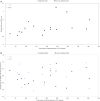Validity of Early Outcomes as Indicators for Comparing Hospitals on Quality of Stroke Care
- PMID: 37042276
- PMCID: PMC10227257
- DOI: 10.1161/JAHA.122.027647
Validity of Early Outcomes as Indicators for Comparing Hospitals on Quality of Stroke Care
Abstract
Background Insight into outcome variation between hospitals could help to improve quality of care. We aimed to assess the validity of early outcomes as quality indicators for acute ischemic stroke care for patients treated with endovascular therapy (EVT). Methods and Results We used data from the MR CLEAN (Multicenter Randomized Controlled Trial of Endovascular Treatment for Acute Ischemic Stroke in the Netherlands) Registry, a large multicenter prospective cohort study including 3279 patients with acute ischemic stroke undergoing EVT. Random effect linear and proportional odds regression were used to analyze the effect of case mix on between-hospital differences in 2 early outcomes: the National Institutes of Health Stroke Scale (NIHSS) score at 24 to 48 hours and the expanded thrombolysis in cerebral infarction score. Between-hospital variation in outcomes was assessed using the variance of random hospital effects (tau2). In addition, we estimated the correlation between hospitals' EVT-patient volume and (case-mix-adjusted) outcomes. Both early outcomes and case-mix characteristics varied significantly across hospitals. Between-hospital variation in the expanded thrombolysis in cerebral infarction score was not influenced by case-mix adjustment (tau 2=0.17 in both models). In contrast, for the NIHSS score at 24 to 48 hours, case-mix adjustment led to a decrease in variation between hospitals (tau 2 decreases from 0.19 to 0.17). Hospitals' EVT-patient volume was strongly correlated with higher expanded thrombolysis in cerebral infarction scores (r=0.48) and weakly with lower NIHSS score at 24 to 48 hours (r=0.15). Conclusions Between-hospital variation in NIHSS score at 24 to 48 hours is significantly influenced by case-mix but not by patient volume. In contrast, between-hospital variation in expanded thrombolysis in cerebral infarction score is strongly influenced by EVT-patient volume but not by case-mix. Both outcomes may be suitable for comparing hospitals on quality of care, provided that adequate adjustment for case-mix is applied for NIHSS score.
Keywords: National Institutes of Health Stroke Scale; acute ischemic stroke; case‐mix; early outcome; expanded thrombolysis in cerebral infarction; hospitals' patient volume; quality of care.
Figures



References
-
- Krumholz HM, Wang Y, Mattera JA, Wang Y, Han LF, Ingber MJ, Roman S, Normand SLT. An administrative claims model suitable for profiling hospital performance based on 30‐day mortality rates among patients with an acute myocardial infarction. Circulation. 2006;113:1683–1692. doi: 10.1161/CIRCULATIONAHA.105.611186 - DOI - PubMed
Publication types
MeSH terms
LinkOut - more resources
Full Text Sources
Medical

